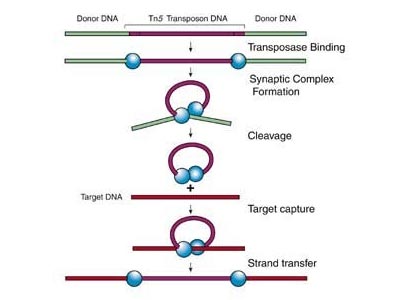日本研究人员称,他们解开了被称为“跳跃基因”的转位子在胚胎干细胞中受到抑制的详细机理。这项成果有望广泛应用于诱导多功能干细胞(iPS细胞)和基因载体的研究。

转位子是具有特定功能的基因片段,它可以自我复制并在基因序列中四处移动。一些转位子有调控基因表达的作用,可诱发基因突变。因此,生物体内存在抑制转位子的机制。通常,这种抑制是通过DNA甲基化来实现的。而在胚胎干细胞中,人们已经发现存在DNA甲基化以外的抑制机理,但详细情况一直未得到解释。
日本京都大学病毒研究所教授真贝洋一等研究人员在利用实验鼠的胚胎干细胞进行实验时发现,如果阻止一种酶“ESET”发挥作用,那么转位子的一种、内源性逆转录病毒在细胞内就会变得异常活跃。与“ESET”正常发挥作用时相比,病毒数量增加到25倍。这说明,“ESET”是控制转位子活跃程度的一种“开关”。
在iPS细胞和基因载体等的研究中,控制特定基因发挥作用是一项非常重要的技术。研究人员表示,这项成果有望广泛应用于iPS细胞和基因载体的研究中。
生物谷推荐原文阅读:
Nature advance online publication 17 February 2010 | doi:10.1038/nature08858
Proviral silencing in embryonic stem cells requires the histone methyltransferase ESET
Toshiyuki Matsui1,2,5, Danny Leung3,5, Hiroki Miyashita1,2, Irina A. Maksakova3, Hitoshi Miyachi1, Hiroshi Kimura4, Makoto Tachibana1,2, Matthew C. Lorincz3 " Yoichi Shinkai1,2
Experimental Research Center for Infectious Diseases, Institute for Virus Research, and,
Graduate School of Biostudies, Kyoto University, 53 Shogoin, Kawara-cho, Sakyo-ku, Kyoto 606-8507, Japan
Department of Medical Genetics, Life Sciences Institute, The University of British Columbia, Vancouver, British Columbia V6T 1Z3, Canada
Graduate School of Frontier Biosciences, Osaka University, Suita, Osaka 565-0871, Japan
These authors contributed equally to this work.
Endogenous retroviruses (ERVs), retrovirus-like elements with long terminal repeats, are widely dispersed in the euchromatic compartment in mammalian cells, comprising ~10% of the mouse genome1. These parasitic elements are responsible for <10% of spontaneous mutations2. Whereas DNA methylation has an important role in proviral silencing in somatic and germ-lineage cells3, 4, 5, an additional DNA-methylation-independent pathway also functions in embryonal carcinoma and embryonic stem (ES) cells to inhibit transcription of the exogenous gammaretrovirus murine leukaemia virus (MLV)6, 7, 8. Notably, a recent genome-wide study revealed that ERVs are also marked by histone H3 lysine 9 trimethylation (H3K9me3) and H4K20me3 in ES cells but not in mouse embryonic fibroblasts9. However, the role that these marks have in proviral silencing remains unexplored. Here we show that the H3K9 methyltransferase ESET (also called SETDB1 or KMT1E) and the Krüppel-associated box (KRAB)-associated protein 1 (KAP1, also called TRIM28)10, 11 are required for H3K9me3 and silencing of endogenous and introduced retroviruses specifically in mouse ES cells. Furthermore, whereas ESET enzymatic activity is crucial for HP1 binding and efficient proviral silencing, the H4K20 methyltransferases Suv420h1 and Suv420h2 are dispensable for silencing. Notably, in DNA methyltransferase triple knockout (Dnmt1 -/- Dnmt3a -/- Dnmt3b -/-) mouse ES cells, ESET and KAP1 binding and ESET-mediated H3K9me3 are maintained and ERVs are minimally derepressed. We propose that a DNA-methylation-independent pathway involving KAP1 and ESET/ESET-mediated H3K9me3 is required for proviral silencing during the period early in embryogenesis when DNA methylation is dynamically reprogrammed.







